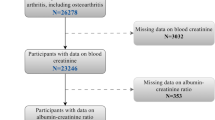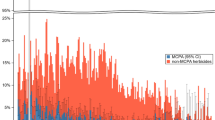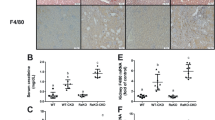Abstract
Background:
The aims of this study were to determine which of the two biomarkers of renal injury, kidney injury molecule-1 or cystatin C, is more sensitive and to evaluate whether erythropoietin protects kidneys injured by perinatal asphyxia.
Methods:
Animals were split into three groups designated as follows: AE, pups that survived perinatal asphyxia and subsequently received 2.5 μg (0.1 ml) of darbepoetin-α (i.p.); A, the pups that survived perinatal asphyxia and received 0.1 ml of 0.9% NaCl; and C, control group. The pups were killed at different ages of life (6 h, 24 h, 48 h, 7 d, and 14 d of age; 10 rats in each subgroup). Immunohistopathological evaluation of kidneys was performed.
Results:
At 48 h and on days 7 and 14, absolute injury scores were significantly lower in group AE as measured by both biomarkers. Cystatin C expression was the most intensive 6 h after the hypoxic event (average value of absolute injury score was 2.82) and declined over time. Expression of kidney injury molecule-1 was less intensive, with the average value of absolute injury score being 2.02 at 6 h and 2.105 at 24 h; the peak value (2.155) was recorded 48 h after the hypoxic event.
Conclusion:
Erythropoietin has a protective effect on hypoxic kidneys. Cystatin C is more sensitive as an early biomarker of acute kidney injury in comparison with kidney injury molecule-1.
Similar content being viewed by others
Log in or create a free account to read this content
Gain free access to this article, as well as selected content from this journal and more on nature.com
or
References
Askenazi DJ, Namasiwayam A, Goldstein SL . Acute kidney injury in critically ill newborns: What do we know? What do we need to learn? Ped Nephrol 2009;24:265–274.
Gupta BD, Sharma P, Bagla J, Parakh M, Soni JP . Renal failure in asphyxiated neonates. Indian Pediatr 2005;42:928–34.
Agras PI, Tarcan A, Baskin E, Cengiz N, Gürakan B, Saatci U . Acute renal failure in the neonatal period. Ren Fail 2004;26:305–9.
Trof RJ, Di Maggio F, Leemreis J, Groeneveld AB . Biomarkers of acute renal injury and renal failure. Shock 2006;26:245–53.
Liangos O, Perianayagam MC, Vaidya VS, et al. Urinary N-acetyl-beta-(D)-glucosaminidase activity and kidney injury molecule-1 level are associated with adverse outcomes in acute renal failure. J Am Soc Nephrol 2007;18:904–12.
Finney H, Newman DJ, Thakkar H, Fell JM, Price CP . Reference ranges for plasma cystatin C and creatinine measurements in premature infants, neonates, and older children. Arch Dis Child 2000;82:71–5.
Coca SG, Yalavarthy R, Concato J, Parikh CR . Biomarkers for the diagnosis and risk stratification of acute kidney injury: a systematic review. Kidney Int 2008;73:1008–16.
de Borst MH, van Timmeren MM, Vaidya VS, et al. Induction of kidney injury molecule-1 in homozygous Ren2 rats is attenuated by blockade of the renin-angiotensin system or p38 MAP kinase. Am J Physiol Renal Physiol 2007;292:F313–20.
Han WK, Bailly V, Abichandani R, Thadhani R, Bonventre JV . Kidney injury molecule-1 (KIM-1): a novel biomarker for human renal proximal tubule injury. Kidney Int 2002;62:237–44.
Nguyen MT, Devarajan P . Biomarkers for the early detection of acute kidney injury. Pediatr Nephrol 2008;23:2151–7.
Herget-Rosenthal S, Marggraf G, Hüsing J, et al. Early detection of acute renal failure by serum cystatin C. Kidney Int 2004;66:1115–22.
Joyeux-Faure M . Cellular protection by erythropoietin: new therapeutic implications? J Pharmacol Exp Ther 2007;323:759–62.
Bogoyevitch MA . An update on the cardiac effects of erythropoietin cardioprotection by erythropoietin and the lessons learnt from studies in neuroprotection. Cardiovasc Res 2004;63:208–16.
Chong ZZ, Kang JQ, Maiese K . Hematopoietic factor erythropoietin fosters neuroprotection through novel signal transduction cascades. J Cereb Blood Flow Metab 2002;22:503–14.
Moore E, Bellomo R . Erythropoietin (EPO) in acute kidney injury. Ann Intensive Care 2011;1:3.
Mak RH . Acute kidney injury in children: the dawn of a new era. Pediatr Nephrol 2008;23:2147–9.
Goldstein SL . Pediatric acute kidney injury: it’s time for real progress. Pediatr Nephrol 2006;21:891–5.
American Society of Nephrology. American Society of Nephrology Renal Research Report. J Am Soc Nephrol 2005;16:1886–1893.
Zerhouni E . The NIH roadmap. Science 2003;302:63–65.
Krawczeski CD, Vandevoorde RG, Kathman T, et al. Serum cystatin C is an early predictive biomarker of acute kidney injury after pediatric cardiopulmonary bypass. Clin J Am Soc Nephrol 2010;5:1552–7.
Zaffanello M, Franchini M, Fanos V . Is serum cystatin-C a suitable marker of renal function in children? Ann Clin Lab Sci 2007;37:233–40.
Askenazi DJ, Koralkar R, Hundley HE, et al. Urine biomarkers predict acute kidney injury in newborns. J Pediatr 2012;161:270–5.e1.
Royakkers AA, Korevaar JC, van Suijlen JD, et al. Serum and urine cystatin C are poor biomarkers for acute kidney injury and renal replacement therapy. Intensive Care Med 2011;37:493–501.
Elmas AT, Tabel Y, Elmas ON . Serum cystatin C predicts acute kidney injury in preterm neonates with respiratory distress syndrome. Pediatr Nephrol 2013;28:477–84.
Kandasamy Y, Smith R, Wright IM . Measuring cystatin C to determine renal function in neonates. Pediatr Crit Care Med 2013;14:318–22.
Vaidya VS, Remirez V, Ichimura T, Bobadilla NA, Bonventre JV . Urinary kidney injury molecule-1: a sensitive quantitative biomarker for early detection of kidney tubular injury. Am J Physiol Renal Physiol 2006;290:F519–F529.
Han WK, Wagener G, Zhu Y, Wang S, Lee HT . Urinary biomarkers in the early detection of acute kidney injury after cardiac surgery. Clin J Am Soc Nephrol 2009;4:873–82.
Humphreys BD, Czerniak S, DiRocco DP, Hasnain W, Cheema R, Bonventre JV . Repair of injured proximal tubule does not involve specialized progenitors. Proc Natl Acad Sci USA 2011;108:9226–31.
Bonventre JV . Kidney injury molecule-1 (KIM-1): a urinary biomarker and much more. Nephrol Dial Transplant 2009;24:3265–8.
Maiese K, Li F, Chong ZZ . Erythropoietin in the brain: can the promise to protect be fulfilled? Trends Pharmacol Sci 2004;25:577–83.
Ates E, Yalcin AU, Yilmaz S, Koken T, Tokyol C, Ates E . Protective effect of erythropoietin on renal ischemia and repercussion injury. ANZ J Surg 2005;75:1100–1105.
Sharples EJ, Patel N, Brown P, et al. Erythropoietin protects the kidney against the injury and dysfunction caused by ischemia-reperfusion. J Am Soc Nephrol 2004;15:2115–24.
Spandou E, Tsouchnikas I, Karkavelas G, Dounousi E, Simenidou C, Guiba-Tziampiri O . Erythropoietin attenuates renal injury in experimental acute renal failure ischaemic/reperfusion model. Nephrol Dial Transplant 2006;21:330–336.
Vesey DA, Cheung C, Pat B, Endre Z, Gobé G, Johnson DW . Erythropoietin protects against ischaemic acute renal injury. Nephrol Dial Transplant 2004;19:348–55.
Author information
Authors and Affiliations
Corresponding author
Rights and permissions
About this article
Cite this article
Stojanović, V., Vučković, N., Barišić, N. et al. Early biomarkers of renal injury and protective effect of erythropoietin on kidneys of asphyxiated newborn rats. Pediatr Res 76, 11–16 (2014). https://doi.org/10.1038/pr.2014.50
Received:
Accepted:
Published:
Issue date:
DOI: https://doi.org/10.1038/pr.2014.50
This article is cited by
-
Comparative Study of the Severity of Renal Damage in Newborn and Adult Rats under Conditions of Ischemia/Reperfusion and Endotoxin Administration
Bulletin of Experimental Biology and Medicine (2018)
-
Urinary kidney injury molecule-1 rapid test predicts acute kidney injury in extremely low-birth-weight neonates
Pediatric Research (2015)



